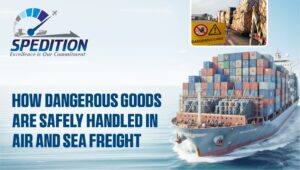How Dangerous Goods Are Safely Handled in Air and Sea Freight
From everyday consumer items like perfumes and batteries to heavy-duty chemicals and gases, dangerous goods (DG) move across the globe every single day. They’re essential for industries, healthcare, energy, and modern lifestyles—but they also carry risks. A simple mistake in handling, packaging, or documentation could mean safety hazards, regulatory fines, or even major accidents.
That’s why transporting DG cargo is never business-as-usual. It demands knowledge, strict compliance with international standards, and the right logistics partner to ensure everything—from packaging to final delivery—is done correctly and safely.
While air freight is known for speed, it has stricter DG limits. Sea freight, on the other hand, is better suited for bulk shipments, but it requires careful planning and monitoring. In this blog, we’ll break down how DG cargo is safely managed across these two modes, explaining regulations, packaging, documentation, and the role of technology and expert logistics providers.
If your business often ships internationally, you may want to explore the specialized services of an experienced air freight company in India, which ensures full compliance for DG shipments.
Understanding Dangerous Goods
What Are Dangerous Goods?
Dangerous goods include substances or items that, when mishandled, can pose risks to people, property, or the environment. This doesn’t only mean industrial explosives—many common products fall into the category:
- Lithium batteries in laptops and phones
- Paints, perfumes, and aerosols
- Disinfectants, pesticides, and cleaning chemicals
- Flammable liquids like alcohol-based solutions
The first step for shippers is understanding how their products are classified.
DG Classification: Hazard Classes
Globally, dangerous goods are divided into nine hazard classes, covering everything from explosives (Class 1) to miscellaneous goods like lithium batteries (Class 9). Proper classification tells you more than just the danger—it outlines how the cargo must be packaged, marked, and transported safely.
Regulatory Frameworks
DG compliance isn’t optional. Two main international bodies regulate shipments:
- For air freight, the IATA Dangerous Goods Regulations (IATA DGR) dictate handling rules that all airlines follow.
- For sea freight, the IMO’s International Maritime Dangerous Goods (IMDG) Code sets global standards for shipping companies.
If you’re selecting a logistics partner, it’s important to verify credentials such as their affiliations and certifications, which prove their ability to manage DG shipments according to international law.
Packaging and Labeling Dangerous Goods
Packaging is the frontline defense against DG risks. A shipment that isn’t packed correctly can leak, combust, or cause contamination during transit.
Packaging for Air vs. Sea
- Air freight packaging must be light, secure, and pressure-tested to withstand in-flight conditions.
- Sea freight packaging needs to be durable, moisture-resistant, and able to endure long transits across rough seas.
Logistics teams commonly use UN-certified steel drums, fiberboard boxes, and heavy-duty plastic containers—often combined with cushions or liners for additional safety.
The Role of Labels and Marks
Each DG package must clearly show:
- Hazard labels in color-coded diamonds
- UN identification numbers
- Handling marks like “This Way Up” or “Keep Dry”
For especially sensitive cargo—like infectious or biomedical substances—the triple packaging system is mandatory: an inner container, a sealed secondary casing, and a robust outer box.
Leading companies that specialize in aviation cargo handling services often have systems in place to double-check that packaging and labels meet international guidelines before shipments are even accepted.
Documentation and Compliance
Even perfectly packaged DG cargo won’t move without the correct paperwork. In fact, incomplete documentation is one of the biggest reasons DG shipments get delayed or rejected at checkpoints.
Essential Documents
- Shipper’s Declaration for Dangerous Goods (SDDG): Required under IATA DGR for air shipments.
- Safety Data Sheet (SDS): Explains risks and safe handling measures.
- Commercial Invoice & Packing List: Standard trade documents but specifically tailored for DG descriptions.
Air Freight Compliance (IATA)
Airlines follow highly structured DG acceptance checks. Every shipment requires validated documentation and an inspection against packaging rules. Certain goods, like lithium batteries, face quantity restrictions.
Sea Freight Compliance (IMDG)
For sea shipments, crew members are trained under the IMDG Code. Manifests must detail each DG container, and stowage plans ensure proper segregation of incompatible cargo.
To avoid shipment holds or fines, businesses often rely on logistics partners who manage pre-clearance and verification of all documents. Working with providers that offer compliance solutions for dangerous goods can mean the difference between smooth shipping and costly setbacks.
Handling DG Cargo in Air Freight
Air freight is fast but leaves very little margin for error due to in-flight safety requirements. Here’s how DG cargo moves through the air logistics chain:
- Cargo Acceptance & Screening – Shippers provide documentation; airlines check packaging and labels.
- Segregation – Hazardous shipments are separated from incompatible materials.
- ULD Loading – Cargo is secured into Unit Load Devices, ensuring no leaks and even weight distribution.
- In-flight Handling – Pilots are informed of DG onboard; aircraft carry fire suppression systems and spill-response kits.
- Arrival & Unloading – Cargo is offloaded in designated DG handling areas at arrival airports.
Some cargo like lithium batteries or aerosols receive extra scrutiny due to their high in-flight risk of overheating or pressure build-up.
If your business moves DG frequently, it’s advisable to partner with an air freight specialist for dangerous goods who understands the limits and permits specific to air transport.
Handling DG Cargo in Sea Freight
Sea freight, by contrast, offers flexibility for larger or bulk dangerous goods shipments—but planning is just as critical.
DG Cargo Workflow at Sea
- Container Selection: DG-certified containers inspected before loading.
- Stowage Planning: Placement follows the IMDG Code, with incompatible substances separated.
- Securing and Lashing: Containers are lashed tightly to withstand movement in rough seas.
- Monitoring in Transit: Crews track temperature, humidity, and ventilation.
- Port Arrival: DG containers are unloaded by trained handlers and checked against port customs rules.
Sea freight tends to be the more cost-effective option for industries moving large hazardous shipments. Many companies prefer it for chemicals, fuels, or bulk liquid cargo.
To see how professional associations guide safe practices, take a look at the memberships and industry bodies we’re associated with.
Technology and Safety Innovations
Technology has greatly improved the way DG shipments are monitored and managed today.
- Real-time tracking systems allow transparency at every step.
- IoT sensors alert teams to changes in temperature, humidity, or pressure inside containers.
- Automated scanning helps detect undeclared DG cargo trying to bypass safety rules.
- Digital compliance platforms reduce errors when preparing important DG declarations.
These innovations give shippers peace of mind that their shipments remain safe, compliant, and visible. For more insights into where the industry is heading, explore our logistics blogs and expert tips.
Challenges and Expert Solutions
Common Challenges Shippers Face
- Misclassification of items
- Incorrect or unclear labeling
- Documentation delays
- Different regulations depending on the country
Solutions That Work
- Partnering with certified DG logistics experts
- Providing regular staff training
- Having contingency response plans for accidents or spills
An experienced provider anticipates problems before they happen, ensuring DG cargo reaches safely and on time.
Choosing the Right Logistics Partner
Transporting dangerous goods isn’t something businesses can afford to experiment with. It requires the right mix of certification, experience, and infrastructure.
When choosing a logistics partner, look for:
- Trained staff certified in DG handling
- Proven compliance with IATA and IMDG rules
- A strong track record in managing DG shipments safely
- Integrated services covering packaging, labeling, and documentation
For businesses looking to grow internationally, working with a trusted logistics company like Spedition India gives you confidence that every step, from cargo acceptance to delivery, will meet global safety standards.
Conclusion
Dangerous goods play a vital role in today’s global economy—but their transport comes with challenges that demand careful management. From classification and packaging to compliance with IATA and IMDG rules, every step matters for safety.
Air freight offers speed but tighter quantity limits. Sea freight caters to bulk cargo under detailed stowage regulations. Across both, technology and expert partners ensure compliance, reduce risks, and keep goods moving without interruptions.
If your business needs safe, compliant, and reliable DG logistics support, reach out to our team of specialists who can guide you through every stage of DG cargo handling.



